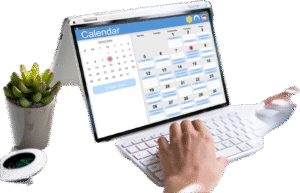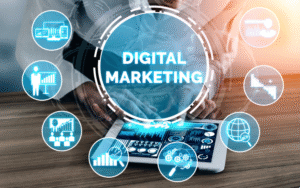Digital marketing for small businesses doesn’t have to be complicated or expensive. With the right strategies and tools, even businesses with limited budgets can compete online, reach their ideal customers, and grow their revenue effectively.
Whether you’re just starting or looking to improve your current efforts, this guide breaks down everything you need to know about digital marketing for small business success. From choosing the right channels to measuring your results, we’ll help you build a strategy that actually works for your goals and budget.
What is Digital Marketing for Small Businesses?

Digital marketing for small businesses refers to all online marketing activities that help you connect with potential customers where they spend their time: on the internet.
Unlike traditional marketing methods like print ads or billboards, digital marketing lets you target specific audiences, track your results in real time, and adjust your approach based on what’s working.
Why Small Businesses Need Digital Marketing
The digital landscape has changed how customers discover and choose businesses. If you’re not showing up online, you’re missing opportunities every single day.
Here’s what makes digital marketing essential for small businesses:
Cost-Effective Reach: You can start with a minimal budget and scale up as you see results. Unlike traditional advertising that requires large upfront costs, digital channels let you test and optimize without breaking the bank.
Targeted Advertising: Reach people who are actually interested in what you offer. You can target by location, interests, behavior, and demographics, making every dollar count.
Measurable Results: See exactly what’s working through analytics and data. You’ll know how many people saw your ad, clicked your link, or made a purchase.
Level Playing Field: Small businesses can compete with larger companies by being creative, authentic, and responsive. Your personality and customer service can be your biggest advantages.
Core Components of Small Business Digital Marketing
Digital marketing includes several key areas that work together to build your online presence:
- Website and SEO: Your digital storefront that helps people find you through search engines
- Social Media Marketing: Building relationships and brand awareness on platforms where your customers hang out
- Email Marketing: Direct communication with customers who want to hear from you
- Content Marketing: Creating valuable information that attracts and educates your audience
- Paid Advertising: Getting quick visibility through platforms like Google Ads or Facebook Ads
- Local Marketing: Making sure nearby customers can find your business online
Essential Digital Marketing Strategies That Work
Not every digital marketing tactic makes sense for every small business. Your strategy should match your goals, budget, and where your customers actually spend their time online.
Building Your Digital Foundation
Before diving into specific tactics, you need a solid foundation. Your website acts as your home base, everything else points back to it.
Make sure your site loads quickly, works well on mobile devices, and clearly explains what you do and how to contact you. Include customer testimonials, clear calls to action, and easy navigation.
Search engine optimization (SEO) helps people find your website when they search for products or services like yours. Focus on local SEO if you serve a specific area by claiming your Google Business Profile and getting listed in local directories.
Social Media Marketing for Small Businesses

Social media gives you direct access to your customers without paying for ads (though paid promotion can boost your reach). The key is choosing the right platforms rather than trying to be everywhere at once.
Platform Selection Guide:
| Platform | Best For | Content Type | Time Investment |
| Local businesses, broad audiences | Posts, videos, events, groups | Moderate | |
| Visual businesses, younger audiences | Photos, stories, reels | High | |
| B2B services, professional services | Articles, updates, networking | Moderate | |
| TikTok | Creative brands, Gen Z audiences | Short videos, trends | High |
Pick one or two platforms where your ideal customers spend time and do them well rather than spreading yourself too thin. Post consistently, engage with comments, and share content that provides value, not just sales pitches.
Email Marketing That Converts

Email remains one of the highest-ROI digital marketing channels for small businesses. Build your email list by offering something valuable in exchange for an email address: a discount code, free guide, or exclusive content.
Send emails regularly but not too frequently. Weekly or bi-weekly works for most small businesses. Share useful tips, announce new products or services, and include special offers for your subscribers.
Segment your list based on customer behavior or interests so you can send more relevant messages. Someone who bought from you needs different emails than someone who just signed up for your newsletter.
Content Marketing Basics
Content marketing means creating helpful, interesting information that attracts potential customers to your business. This could be blog posts, videos, podcasts, infographics, or guides.
The goal isn’t to directly sell but to establish yourself as helpful and knowledgeable in your field. When someone needs what you offer, they’ll remember you helped them.
Write about topics your customers actually care about. Answer their questions, solve their problems, and share your expertise. Use simple language and focus on being helpful rather than impressive.
Tools and Resources for Small Business Marketing
You don’t need expensive software or a big team to handle digital marketing effectively. Several affordable (or free) tools can help you manage your marketing efforts.
Must-Have Marketing Tools
Website and Analytics:
- Google Analytics (free) tracks who visits your site and what they do
- Google Search Console (free) shows how people find you in search results
- Website builders like WordPress or Squarespace for easy site management
Social Media Management:
- Buffer or Hootsuite let you schedule posts across platforms
- Canva helps create professional-looking graphics without design skills
- Later or Planoly for Instagram planning and scheduling
Email Marketing:
- Mailchimp offers free plans for small lists
- Constant Contact provides templates and automation
- ConvertKit works well for creators and service businesses
Project Management: Virtual assistant services can help you stay organized and implement your marketing strategy consistently without hiring full-time staff.
When to Get Help With Digital Marketing for Small Business
Many small business owners try to do everything themselves at first. That’s natural, but it can lead to burnout or inconsistent marketing efforts.
Consider getting help when:
- You’re spending more time on marketing than running your business
- Your marketing efforts are inconsistent because you’re too busy
- You need specific expertise you don’t have (like running paid ads)
- You want to scale faster than you can manage alone
Working with virtual assistants or digital marketing specialists lets you focus on what you do best while ensuring your marketing happens consistently and effectively.
Measuring Your Digital Marketing Success
Tracking the right metrics helps you understand what’s working and where to focus your efforts. You don’t need to measure everything, just the numbers that matter for your goals.
Key Metrics to Monitor
Website Performance:
| Metric | What It Tells You | Target |
| Traffic | How many people visit your site | Steady growth month over month |
| Bounce Rate | If people leave quickly | Under 60% |
| Conversion Rate | Visitors who take action | 2-5% for most industries |
| Page Load Speed | How fast your site loads | Under 3 seconds |
Social Media Metrics: Track engagement rate (likes, comments, shares) rather than just follower count. A smaller, engaged audience is more valuable than a large inactive one.
Email Marketing: Monitor open rates (15-25% is typical), click-through rates (2-5%), and unsubscribe rates (under 0.5%). If your open rates are low, work on better subject lines.
Return on Investment (ROI): Calculate how much revenue your marketing generates compared to what you spend. Even simple tracking, like “How did you hear about us?” at checkou,t helps you understand what’s working.
Making Data-Driven Decisions
Review your metrics monthly and look for patterns. What content gets the most engagement? Which email subject lines get opened? What traffic sources convert best?
Use these insights to do more of what works and less of what doesn’t. Digital marketing isn’t about guessing, it’s about testing, measuring, and improving over time.
Common Digital Marketing Mistakes to Avoid
Small businesses often make predictable mistakes when starting their digital marketing journey. Knowing these pitfalls helps you avoid wasting time and money.
Not Having Clear Goals
Posting on social media “because everyone does it” won’t get you results. Define specific goals: do you want more website traffic, email subscribers, phone calls, or sales? Your goals determine your strategy and metrics.
Trying to Be Everywhere at Once
You can’t effectively manage five social platforms, a blog, email marketing, paid ads, and everything else as a small business. Pick a few tactics that make sense for your business and do them consistently well.
Ignoring Mobile Users
More than half of web traffic comes from mobile devices. If your website doesn’t work well on phones, you’re losing potential customers. Test your site on different devices regularly.
Not Building an Email List
Social media platforms can change their algorithms or rules anytime. Your email list is an asset you own and control. Start building it from day one.
Giving Up Too Soon
Digital marketing takes time to show results. SEO can take months, social media requires consistent effort, and content marketing builds gradually. Stick with your strategy for at least 6-12 months before making major changes.
Getting Started With Your Digital Marketing Plan
Ready to build your digital marketing strategy? Start small and build momentum rather than trying to do everything at once.
Month 1: Foundation Set up or improve your website, claim your Google Business Profile, and start collecting email addresses. Choose one social platform and commit to posting twice per week.
Month 2-3: Content Creation Develop a content calendar and start creating valuable content regularly. This could be blog posts, videos, or social media content that helps your audience.
Month 4-6: Expand and Optimize Add email marketing to your routine, consider paid advertising for quick wins, and start tracking your results more carefully. Adjust based on what’s working.
Ongoing: Consistency and Growth The businesses that succeed with digital marketing are those that show up consistently. Even small, regular efforts compound over time into significant results.
Wrapping Up: Your Path to Digital Marketing for Small Business Success
At VA4 Growth, we specialize in helping small businesses succeed online without needing a huge budget or a large team. Success comes from knowing your customers, showing up consistently, and delivering real value where it matters most.
We make digital marketing simple, starting with a strong website, the right social platforms, and effective email marketing. From there, we track results, refine strategies, and scale your efforts as your business grows.
The businesses winning online aren’t always the biggest, they’re the ones with clear communication, authentic connections, and consistent marketing. That’s where VA4 Growth comes in.
👉 Ready to grow smarter, not just bigger? Contact VA4 Growth today, and let’s build a marketing plan that fits your business.
Frequently Asked Questions About Digital Marketing for Small Businesses
How much should a small business spend on digital marketing?
Most small businesses should allocate 7-12% of their revenue to marketing, with at least half of that going to digital channels. If you’re just starting out, begin with $300-500 per month for tools and basic advertising, then scale up as you see results. Focus on free or low-cost tactics like organic social media and content creation before investing heavily in paid ads.
What digital marketing strategy works best for small businesses?
The best strategy depends on your specific business and customers, but most small businesses see strong results from a combination of local SEO, social media presence, and email marketing. Start by making sure customers can find you in local searches, then build relationships through social media and email. This foundation works for almost any small business.
How long does it take to see results from digital marketing?
Expect to see initial results from paid advertising within days or weeks, while organic strategies like SEO and content marketing typically take 3-6 months to gain traction. Social media growth varies but generally shows momentum after 2-3 months of consistent posting. The key is staying consistent and not giving up before your efforts have time to compound.
Can I do digital marketing myself or should I hire help?
Many small business owners successfully handle their own digital marketing, especially when starting out. However, as your business grows, working with virtual assistants or specialists for specific tasks (like paid ads or content creation) often makes sense. Start by learning the basics yourself, then delegate tasks that take too much time or require specialized expertise.
What are the most important digital marketing channels for small businesses?
The most effective channels are typically your website with local SEO, Google Business Profile, one or two social media platforms where your customers are active, and email marketing. For service-based businesses, LinkedIn and local directories matter more. For visual products, Instagram and Pinterest work well. Choose based on where your specific customers spend their time online.
How do I measure if my digital marketing is working?
Track metrics that tie directly to your business goals. For most small businesses, this means monitoring website traffic, conversion rates (how many visitors become customers), email list growth, and revenue generated from digital channels. Use Google Analytics for website data and built-in analytics from social and email platforms. The simplest measure is asking new customers how they found you.





